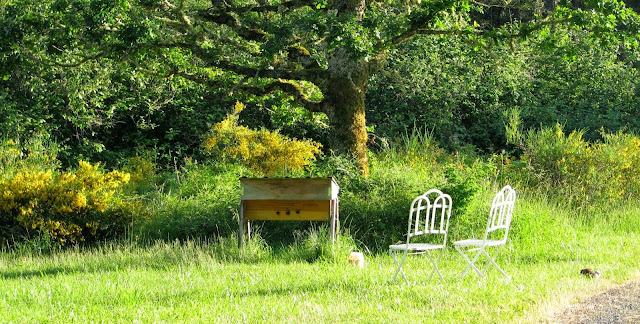Where do you start when your raspberries look like this?
Get down under them and you can see pretty easily which ones need to go.
 |
| It is very clear here, which canes are new and which are old. Green means new, Brown means old. |
 |
| Raspberries at their peak in June. |
 |
| If you look closely at the dark cane left of center you will see that it has been topped. It compensated by making long side branches for more fruit. |
 |
| The raspberry bed looks pretty sparse after pruning but it will be very lush by next June. |
The canes you picked the fruit off of are called floricanes and they have given their raspberries and are now going to turn brown and die.
Next year the primocanes graduate and become floricanes, which bloom (floral) and make berries.
And so on.
You don't have to prune out the old canes but pruning out the old spent canes makes room for sun to come in to the fruiting canes next summer. The more sun they get, the sweeter and yummier the berries are. So to me it's worth it.
If you have everbearing raspberries the process is different. Although I know gardeners who have started mowing down their everbearing varieties in the early spring so they will get one crop in the late summer instead of two small crops in the spring and fall. They would rather have one bearing of fruit than just little dribbles of fruit in the spring and fall.
Now the warning. This is a case of "Do as I say and not as I do" or better, "learn from my mistake".
When you see this:
What do you feel? That's just what I was feeling last summer. So with that gluttonous mood driving me, I dug up several little Tulameen plants from the garden and planted another row near my blueberries. It seemed like the logical place, since the earth was already fluffy, weed free and the drip system was already set up there.
What a mistake. Don't plant raspberries near blueberries.
They love to send runners all through the sawdust mulch around the blueberries and if you go to pull the raspberry runners out, they rip up the shallow roots of the blueberries. And without completely uprooting the blueberries you can't get all of the raspberry runners out.
What a sad discovery this is for me. I had just gotten my first small crop of blueberries this year and getting rid of the raspberries will surely set the blueberries back a year.
Live and learn.






